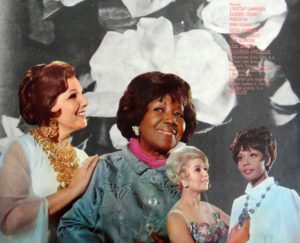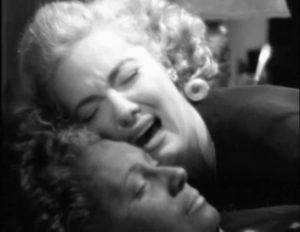
Performing Blackness in Mexican Cinema: Eusebia Cosme, Rita Montaner and Juan José Laboriel
Today, Mediático is delighted to belatedly present for Black History Month three excellent film essays and accompanying text by regular contributor, independent researcher Roberto Carlos Ortiz. Ortiz’s prefaces his film essays with some timely observations about the inclusion of Blaxican R&B star Miguel on the soundtrack of Disney Pixar’s Coco and in the performance of “Remember Me” at the 90th Oscars ceremony last Sunday. Ortiz’ film essays reassess the role of three black actors (Cubans Eusebia Cosme and Rita Montaner and Honduran Juan José Laboriel) in several purportedly “anti-racist” films from classical Mexican Cinema. The short essay accompanying these film essays goes from Miguel to talk about contemporary colorism debates and asks how, in light of these debates, we can reassess and honor the performances of largely forgotten black artists who often played stereotypes. Ortiz’ other posts on for Mediático focus on Holly Woodlawn and Maria Montez
Performing Blackness in Mexican Cinema: Eusebia Cosme, Rita Montaner and Juan José Laboriel
by Roberto Ortiz
Too proper for the black kids /
Too black for the Mexicans
– Miguel, “What’s Normal Anyway?”
During the 2018 Oscars, Blaxican R&B singer Miguel joined Mexican pop star Natalia Lafourcade for a bilingual pop rendition of Coco’s theme song “Remember Me.” The colorful production number may have seemed more evocative of Disney’s The Three Caballeros (1944) than the “culturally aware” Coco. However, the presence of a Blaxican man at the center of the stereotypical Mexican fiesta is important. With his dreadlocks and black skin, the R&B sex symbol offered a different visual of Mexican identity than his cinematic namesake. Designed by Honduran Carlos Campos, who has cited queer Mexican singer Juan Gabriel as source of inspiration for a recent collection, Miguel’s stylish outfit paid minimalist homage to traditional mariachi suits (like the ones worn by the dancers). The inclusion of the Blaxican singer is a welcome addition to a cultural imaginary that has excluded Afro-Mexicans. According to Variety, Disney’s VP of music proposed the addition of the pop version of “Remember Me.” Though anchored in Mexican traditions, Coco shares with previous Disney and Mexican Golden Age movies a desire of pan-Latino identification. (Guatemalan actor Oscar Isaac shouted “Viva Latinoamérica” before announcing Coco’s Oscar win.) The choice of Miguel for the Coco soundtrack is indicative of how US cultural sensibilities and identity politics inform Pixar’s celebration of Mexican culture, including an increasing awareness of intersecting black and Latino identities.
At the start of January 2018, two videos triggered discussions about the intersection of black and Latino (or Latinx) identities. The premiere of VH1 reality series Love & Hip-Hop: Miami featured Dominican singer Amara La Negra rejecting the suggestion of Puerto Rican producer Young Hollywood to alter her “Afrocentric” image in order to be commercially successful like Beyoncé, JLo or Shakira.
Two days later, Puerto Rican-Filipino Bruno Mars and Dominican Cardi B released their retro video for “Finesse (Remix),” which paid tribute to In Living Color (1990 – 1994), the Keenen and Damon Wayans comedy sketch show, whose dance troupe (the Fly Girls, choreographed by Rosie Perez) included an unknown Jennifer Lopez.
The videos generated debates about light-skin privilege that largely focused on the contrasting looks between the two Afro-Dominican women – darker-skinned Amara and lighter-skinned Cardi B – and the efforts to create awareness about colorism and Afro-Latinidad continued over the course of a Black History Month in which black and Latino identities converged in the media in other ways.
Amara La Negra and Miguel may seem like unlikely entry points into the history of Mexican cinema. However, these contemporary debates about anti-blackness, authenticity and light-skin privilege have been on my mind while reviewing clips that sought to illustrate the performances of blackness in Mexican films from the 1940s to the 1970s. At a time where Afro-Latino performers are increasing visibility, defying categorizations and refusing to pick sides about intersecting black and Latino identities, how can I best reassess and honor the performances of largely forgotten black artists who often played stereotypes? Transnational media history links them to contemporary black artists like Amara la Negra. As other “crossover” Latino artists, Amara had a previous career in Spanish-language media, including performing as a child in Univision variety show Sábado Gigante. In interviews, Amara has criticized the limited options for black actors in popular Latin American TV genres like telenovelas, serialized melodramas that prolonged the stereotypes of black identity previously seen in Mexican films, which in turn were influenced by 1940s and 50s Cuban radio serials (the basis of many telenovelas), Hollywood “race films” and even 1970s “Blaxploitation.”
While recent articles and documentaries like Costa Chica, Pueblos negros de México (Nicolas Segovia, 2015) seek to document and recognize Afro-descendants in Mexico, these “old” Mexican movies link blackness and racial mixture mainly to the non-Mexican Caribbean. The majority of the black actors and musicians featured in Mexican films during the classical era were born in Cuba (musicians Kiko Mendive, Silvestre Méndez and Dámaso Perez Prado, singer Rita Montaner, child dancer Pablo Marichal, among others), though some were born in Mexico (singer Toña la negra, Leopoldo Francés), Puerto Rico (composer Rafael Hernández, singer Bobby Capó) and Honduras (actor-musician Juan José Laboriel). Representation from other countries expanded somewhat in the Mexican films of the late 1960s and 70s. In addition to Cuba (reciter Eusebia Cosme) and the Dominican Republic (baseball player Julio César Imbert), Mexican producers also recruited black performers from Perú (singer Robertha), Venezuela (bodybuilder Sergio Oliva) and the United States (model Steve Flanagan, Blaxploitation actress Jeanie Bell, actor Phillip Michael Thomas).
In the classic period, most black performers were featured as musical acts in urban cabarets or tropical locales. Most production numbers were joyful showcases of the latest musical trends: conga, rumba, mambo, cha-cha-cha. There is a racial division of labor in these musical numbers – the dancing bodies of light-skinned women who photograph white are usually at the forefront, privileged by the camera – but there can be moments of interracial flirtation between a black male performer and light-skinned female dancer (like the dance between Cubans Ninón Sevilla and Chimy Monterrey in Víctimas del pecado / Victims of Sin, Emilio Fernández, 1951), though their flirtations are brief, confined to the stage. Celebrating the musical numbers is easier, as they also document some of the top black musicians of the 1940s and 50s.
https://www.youtube.com/watch?v=HOeuDvBX_Gw
Cubans Ninón Sevilla and Chimy Monterrey in Víctimas del pecado / Victims of Sin, Emilio Fernández, 1951)
There is greater challenge reassessing the work of black actors who played in the small but significant number of purportedly “anti-racist” Mexican films about the “tragedy” of being black or a light-skinned afrodescendant. Three key movies sum up their representation of black characters: the selfless black mother and her self-loathing light-skinned daughter in family melodrama Angelitos negros (Little Black Angels, Joselito Rodríguez, 1948 and 1970), the aging mammy in the Cuban anti-abortion melodrama El derecho de nacer (The Right to Be Born, Zacarías Gómez Urquiza, 1952, and Tito Davison, 1966) and the asexual black man in the religious biopic Fray escoba (Friar Broom, Ramón Torrado, 1961) (The latter was a Spanish production, but the popular film launched the career of Cuban actor René Muñoz, who went on to play variations of San Martín de Porres on Mexican television and film.)
My initial contact with these Mexican movies happened while growing up in Puerto Rico, where I saw them on TV. I mostly remember Rosas blancas para mi hermana negra (White Roses for My Black Sister, Abel Salazar, 1970), a maternal melodrama about the interracial friendship between two middle-aged mothers (white Argentine Libertad Lamarque and Afro-Cuban Eusebia Cosme) whose daughters (white Mexican Irma Lozano and Afro-Peruvian Robertha) engage in interracial love affairs that lead to tragedy and a symbolic heart transplant. I later learned the movie premiered first in Puerto Rico and its popularity on the island became part of the prerelease publicity in Mexico, where it didn’t have the same success.

Angelitos negros is probably the best-known one, thanks to the posthumous cult of Pedro Infante. Titled after the Mexican song version of a Venezuelan poem written for Afro-Cuban Eusebia Cosme, Angelitos negros is among the most bizarre movies in classic Mexican cinema, at times wrongly described as a Mexican Imitation of Life. Primarily a vehicle for Pedro Infante, the melodrama tells the story of José Carlos, a popular Mexican singer who sometimes performs in blackface, has a black best friend (dark-skinned Afro-Cuban Chimy Monterrey) and rejects a black love interest (Argentine-born Chela Castro, in blackface). José Carlos falls in love with Ana Luisa de la Fuente (Catalan Emilia Guiú), a blonde schoolteacher who lives with her black nanny Mercé (light-skinned Afro-Cuban Rita Montaner, wearing dark makeup) and is unknowingly “passing” for white. José Carlos learns Ana Luisa is Mercé’s daughter after she gives birth to a black girl. In an absurd plot twist, a priest asks José Carlos – an orphan – to “take the blame” for their black baby. Ana Luisa then rejects her young daughter Belén (Mexican Titina Romay, the director’s daughter, also in blackface) and Mercé suffers witnessing their unhappiness. José Carlos sings the dramatic “Angelitos negros” to his daughter, Ana Luisa denies being Belén’s mother in front of a socialite and Belén uses talcum powder to become white so her racist mommy will love her. It all builds up to a fatal showdown between black mother and white daughter on a staircase (Mildred Pierce meets Imitation of Life) and the movie ends with a final shot of star Pedro Infante looking miserable as the repentant white daughter cries with her black little girl over the body of the dead black nanny.

Depending on your viewpoint, movies like Angelitos negros may cause aversion, indifference or unintentional humor, which was the reaction I saw a few years ago at a conference: the audience laughed when a white scholar showed the scene in which Ana Luisa discovers her baby is black. (Does the excessive melodrama turn the anti-blackness of these films into camp?) For me, reviewing these movies serves the purpose of celebrating the work of black artists who performed in them while holding accountable the anti-black representational strategies in Mexican films, thus reexamining the dubious legacies of Nana Mercé, Mamá Dolores and Fray Martín.






